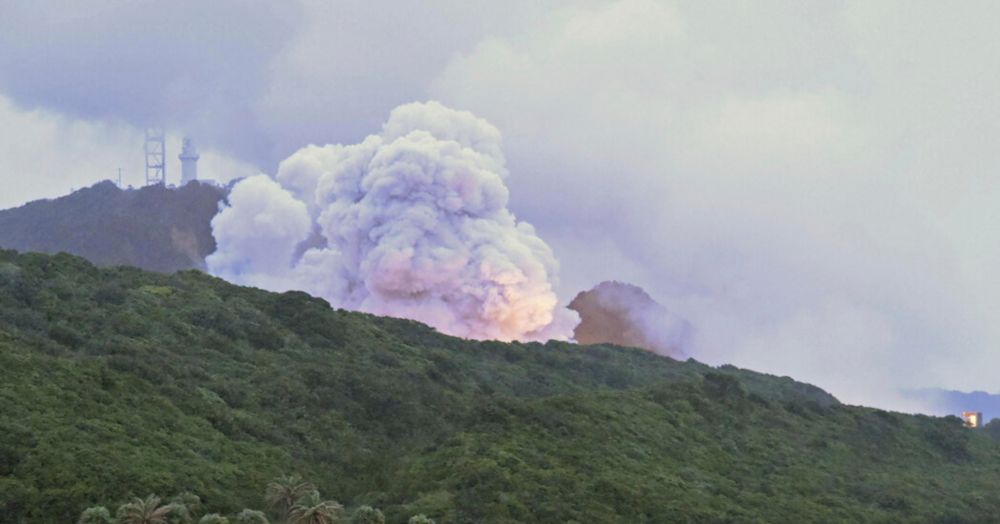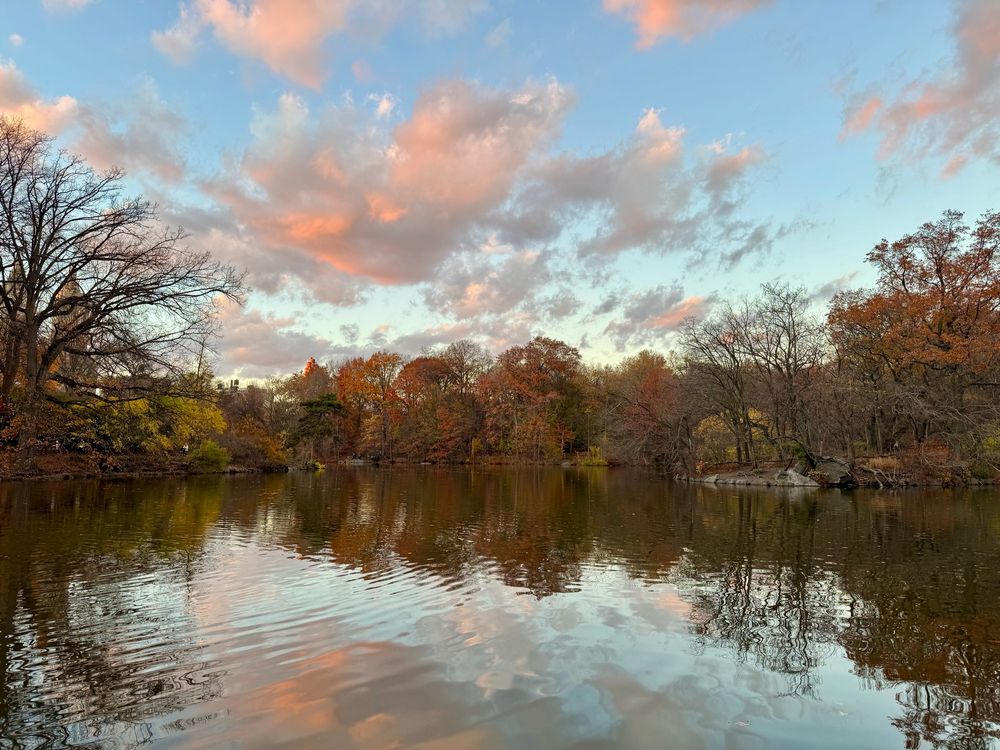
Lake surrounded by late-autumnal trees, beneath a sky of clouds lightly tinted by sunset colors. Lake reflects the sky in a cool Monet-like vibe

Bow Bridge across a lake in Central Park, the lake reflects the bridge so it’s a mirror effect. Sky is tinted with sunset colors
Felled by sickness from a covid booster I got yesterday, but taking the day off got me a nice chance to see pretty sunset vibes in Central Park
27.11.2024 00:17 — 👍 11 🔁 0 💬 1 📌 0
I’ll check out your DM. There isn’t really a tech deaf/hoh “physical” community per se but we have a virtual one on Slack (gated to just deaf/hoh folks tho!). But there’s definitely some good resources up at NTID in Rochester (alumnus here!)
26.11.2024 02:20 — 👍 2 🔁 0 💬 0 📌 0
Hey, this is great! 🖖 Thanks for reaching out. I know about Open Data Week and have always wanted to check it out. My partner, who is deaf too, is a data manager at NYC DOHMH. Can I put you two in touch? And I want to learn more about @beta.nyc too. It looks so fun
25.11.2024 22:09 — 👍 2 🔁 0 💬 1 📌 0
Agreed! And goes back to your original point which is …. it’s a bad naming scheme 🤪 down with medallion
25.11.2024 18:26 — 👍 1 🔁 0 💬 0 📌 0
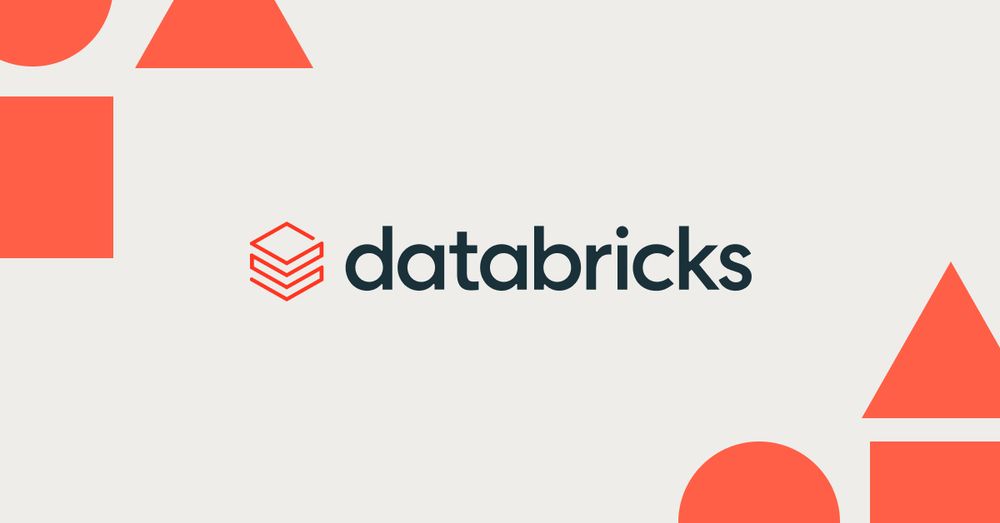
What is a Medallion Architecture?
A medallion architecture is a data design pattern used to logically organize data in a lakehouse, with the goal of improving the structure and quality of data.
That’s what the graphic says but the description at the bottom of the graphic implies there’s no data manipulation happening, it’s a landing zone. The text @ databricks.com/glossary/med... says bronze is “as-is” source data basically
Some clients have interpreted bronze to mean raw source data too
25.11.2024 17:58 — 👍 1 🔁 0 💬 1 📌 0
But also! I really thought bronze was intended by whoever came up w Medallion to represent raw _untouched_ data
25.11.2024 17:01 — 👍 0 🔁 0 💬 1 📌 0
We’ve been talking a lot about this at work lately too! One good idea I heard — “staging” as a data model layer is confusing (due to staging envs, staging dbs, etc) and suggested “sources” for the layer where you import raw data and do light cleanup
25.11.2024 17:01 — 👍 1 🔁 0 💬 1 📌 0
"partly the need to be for others what I needed" isn't an awful reason imo - it's a good motive to want to build a better environment for your reports than the environment you had/needed
22.11.2024 19:35 — 👍 1 🔁 0 💬 1 📌 0
Lots of new followers!
Here's the ✨ Deafies Starter Pack ✨ so you can follow a bunch of deaf/hoh people 🧏 please reply (or DM me) if you want to be added to it go.bsky.app/9cCKqS8
22.11.2024 19:32 — 👍 0 🔁 0 💬 0 📌 0
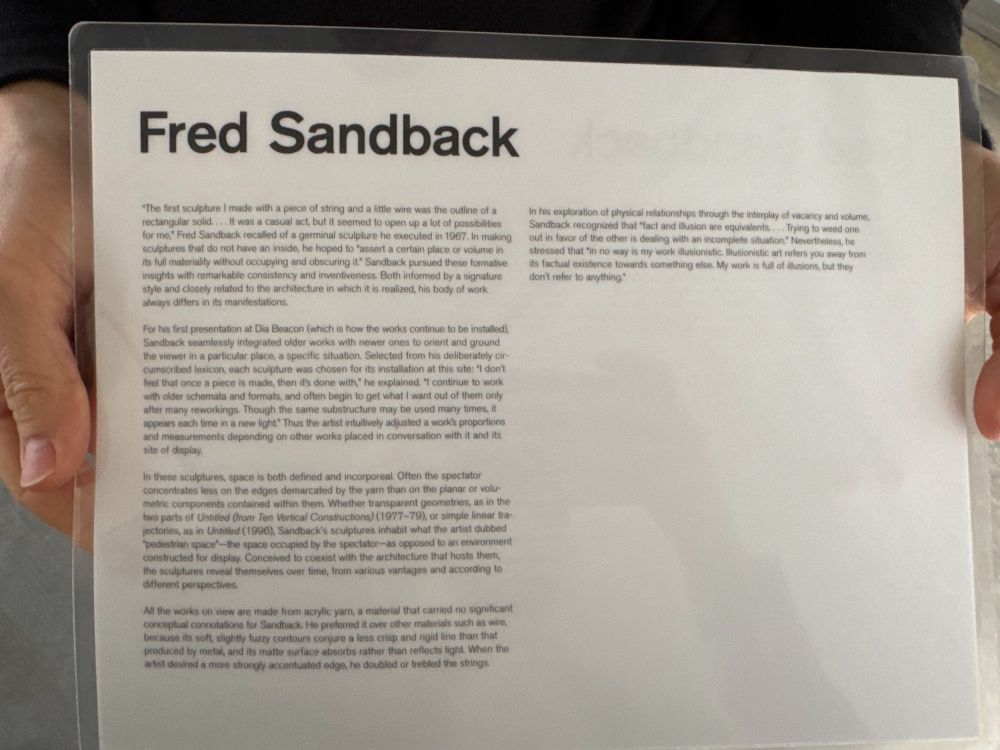
Laminated handout from Dia: Beacon museum about Fred Sandback (see next image for text). 5 paragraphs of text.
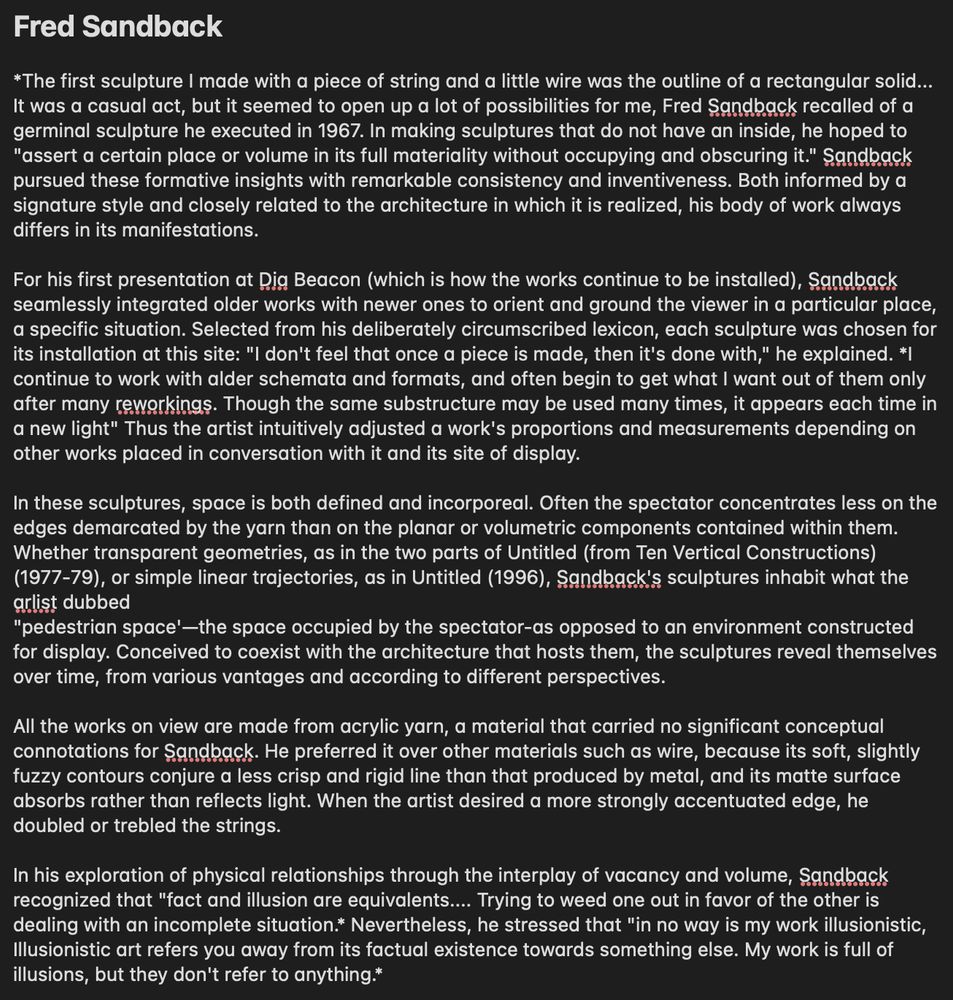
*The first sculpture I made with a piece of string and a little wire was the outline of a rectangular solid... It was a casual act, but it seemed to open up a lot of possibilities for me, Fred Sandback recalled of a germinal sculpture he executed in 1967. In making sculptures that do not have an inside, he hoped to "assert a certain place or volume in its full materiality without occupying and obscuring it." Sandback pursued these formative insights with remarkable consistency and inventiveness. Both informed by a signature style and closely related to the architecture in which it is realized, his body of work always differs in its manifestations.
For his first presentation at Dia Beacon (which is how the works continue to be installed), Sandback seamlessly integrated older works with newer ones to orient and ground the viewer in a particular place, a specific situation. Selected from his deliberately circumscribed lexicon, each sculpture was chosen for its installation at this site: "I don't feel that once a piece is made, then it's done with," he explained. *I continue to work with alder schemata and formats, and often begin to get what I want out of them only after many reworkings. Though the same substructure may be used many times, it appears each time in a new light" Thus the artist intuitively adjusted a work's proportions and measurements depending on other works placed in conversation with it and its site of display. (text truncated from this point)
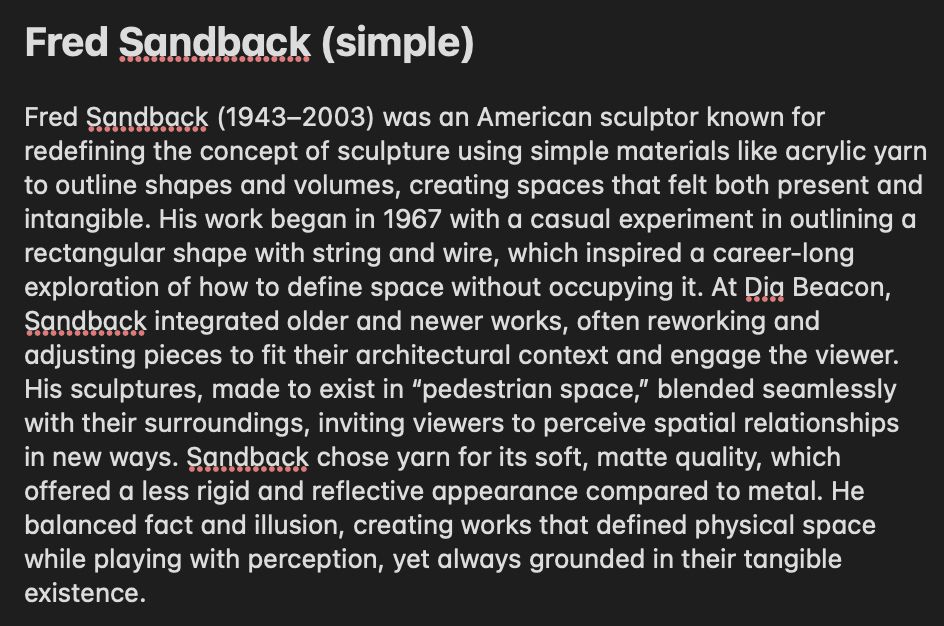
Fred Sandback (1943–2003) was an American sculptor known for redefining the concept of sculpture using simple materials like acrylic yarn to outline shapes and volumes, creating spaces that felt both present and intangible. His work began in 1967 with a casual experiment in outlining a rectangular shape with string and wire, which inspired a career-long exploration of how to define space without occupying it. At Dia Beacon, Sandback integrated older and newer works, often reworking and adjusting pieces to fit their architectural context and engage the viewer. His sculptures, made to exist in “pedestrian space,” blended seamlessly with their surroundings, inviting viewers to perceive spatial relationships in new ways. Sandback chose yarn for its soft, matte quality, which offered a less rigid and reflective appearance compared to metal. He balanced fact and illusion, creating works that defined physical space while playing with perception, yet always grounded in their tangible existence.

Fred Sandback was all about creating art with barely anything—he used simple yarn or string to outline shapes in space, making you feel like there’s something solid when there’s really just air. His minimalist style didn’t fill up the room with heavy materials; instead, he let empty space do the talking, transforming places like Dia Beacon into sites of quiet but powerful illusions. Sandback once said his work isn’t a representation of anything—it just “doesn’t do anything,” which is exactly what makes it intriguing. His art plays with perception, making you question what’s real and what’s simply a trick of the eye.
Good AI use case: Summarize artwork descriptions at museums! Especially if you're at a conceptual art museum that likes to hand out essays. 😵💫 Take a photo of it and ask to rewrite "in simple, plain English."
For extra fun: Ask to do it in a sassy tone or use a different format (sonnet, haiku)
19.11.2024 12:37 — 👍 8 🔁 2 💬 1 📌 0
Added you! ✅
19.11.2024 12:11 — 👍 1 🔁 0 💬 0 📌 0
Added! ✅
19.11.2024 12:11 — 👍 1 🔁 0 💬 0 📌 0
Added! ✅
19.11.2024 12:11 — 👍 0 🔁 0 💬 0 📌 0
Added! ✅
19.11.2024 12:11 — 👍 0 🔁 0 💬 0 📌 0
Done! ✅
16.11.2024 23:03 — 👍 1 🔁 0 💬 1 📌 0
Done!! ✅
16.11.2024 23:02 — 👍 1 🔁 0 💬 0 📌 0
Added! ✅
16.11.2024 23:01 — 👍 1 🔁 0 💬 1 📌 0
Done! ✅
16.11.2024 23:00 — 👍 1 🔁 0 💬 0 📌 0
Chiming in to say I think those silly triangular cocktail glasses shouldn’t be a thing anymore! 🚫🍸 Can we start serving martinis in regular whiskey or highball glasses instead 🥃 🍹 and stop spilling it all over the place?
16.11.2024 22:58 — 👍 1 🔁 0 💬 1 📌 0
Yay we now have MULTIPLE deaf 🧏 starter packs! 🚀
14.11.2024 13:20 — 👍 2 🔁 1 💬 0 📌 0
Done! ✅
13.11.2024 23:20 — 👍 1 🔁 0 💬 1 📌 0
LMK if you want to be added to it
13.11.2024 23:19 — 👍 0 🔁 0 💬 0 📌 0
We have a starter pack! go.bsky.app/9cCKqS8
13.11.2024 23:19 — 👍 1 🔁 1 💬 1 📌 0
I admit nothing 🤫
10.11.2024 21:44 — 👍 1 🔁 0 💬 0 📌 0
we all ought to be proud of our best code, right? now that gives me an idea...Aura frames, but for code snippets
10.11.2024 17:33 — 👍 1 🔁 0 💬 1 📌 0
Also I've been Ben Affleck all this time, who knew?
10.11.2024 04:06 — 👍 2 🔁 0 💬 0 📌 0
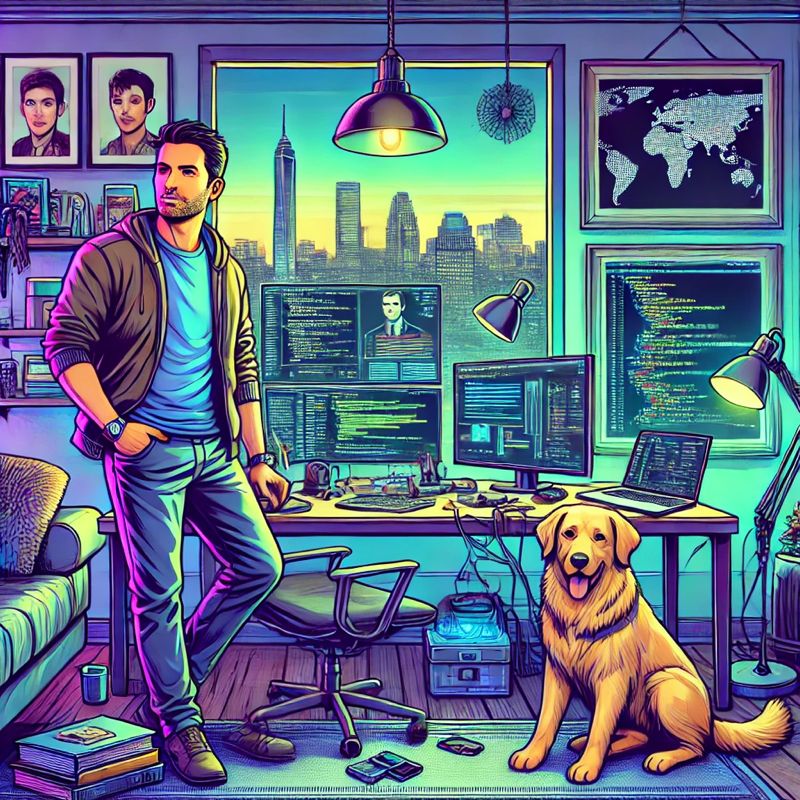
“Illustration of a 44-year-old man’s modern apartment with a view of Washington, D.C. The scene shows a cozy yet tech-focused workspace with dual monitors displaying code and data charts, hinting at his role in analytics engineering. A friendly dog sits nearby, and personal touches like books, travel photos, and framed pictures of two young girls (likely his nieces) are scattered around. The room is bathed in a warm, ambient glow that contrasts with neon cyberpunk colors in blue, purple, and green, blending a high-tech aesthetic with homey warmth.”
“Based on what you know about me. draw a picture of what you think my current life looks like”
That dog is the BEST
10.11.2024 04:04 — 👍 10 🔁 0 💬 1 📌 0
Cognitive Psychologist at the Center for Language and Cognition,
U of Groningen (CLCG), NL | I study how we understand and produce language, especially idioms | 🇩🇪🇳🇱🇬🇧🇪🇺🧶📚 🌸
Professor of cognitive psychology, podcaster, author, guitarist, skier. Husband to Anita, father to Isabel & Fabian, and granddad to Hugo. Follow my Substack newsletter Craving Coherence: https://rolfzwaan.substack.com/.
Postdoc in the Hayden lab at Baylor College of Medicine studying neural computations of natural language & communication in humans. Sister to someone with autism. she/her. melissafranch.com
Cognitive scientist interested in the processing, acquisition and evolution of language; statistical learning; computational modeling.
Lab website: https://csl-lab.psych.cornell.edu
We study the neurobiology of language and its relationship to consciousness, mental health, and wellbeing using neuroimaging and psychedelics at UCL 🧠 🗣️
http://www.lab-lab.org/
UCL Centre for Consciousness Research
https://www.uccr.uk/
#DevLangDis #Aphasia #PPA 💬🧠 1.amanuensis i spesialpedagogikk ved OsloMet, klinisk lingvist fra UniOsloHF. Og sykelig opptatt av sykkel. // assoc.prof in special education @OsloMet, PhD in clinical linguistics from Uni of Oslo. Ask me about my bike
The official(ish) account of the Auditory-VIsual Speech Association (AVISA) AV 👄 👓 speech references, but mostly what interests me avisa.loria.fr
cognitive neuroscientist studying brain oscillations, multimodal language comprehension & production | PI of Communicative Brain lab | assistant professor at Donders Institute & research group leader at MPI for Psycholinguistics - https://lindadrijvers.nl
computational cognitive science he/him
http://colala.berkeley.edu/people/piantadosi/
Director, MIT Computational Psycholinguistics Lab. President, Cognitive Science Society. Chair of the MIT Faculty. Open access & open science advocate. He.
Lab webpage: http://cpl.mit.edu/
Personal webpage: https://www.mit.edu/~rplevy
Psycholinguist @UCDavis. Made in Portugal, raised in Canada, living in California. Author of "Psycholinguistics: A Very Short Introduction" from Oxford University Press, coming out January 23, 2025.
Professor of Cognitive Science, University of Oxford @oxexppsy.bsky.social
Professor of Psychology at Carleton College. Speech, cognition, measurement, open science! Book carver. Podcast: Juice and the Squeeze. she/her. http://juliastrand.com
UT Austin linguist http://mahowak.github.io/. computational linguistics, cognition, psycholinguistics, NLP, crosswords. occasionally hockey?
Official account for the Bergelson Lab at Harvard, sporadically maintained by the PI:).
Just a lab, trying to figure out how babies learn language, somehow caught in the crosshairs of gov't admin battles.
I study language using tools from cognitive science and neuroscience. I also like snuggles.
Professor, psycholinguist
Word Nerd. Professor of Cognitive Psychology. Language Comprehension & Learning. University College London. UCL. Lover of bicycles. Owner of a preloved kidney.
Language in minds, brains, and machines. Linguistics prof
@Stanford. He/him. https://climblab.org/


